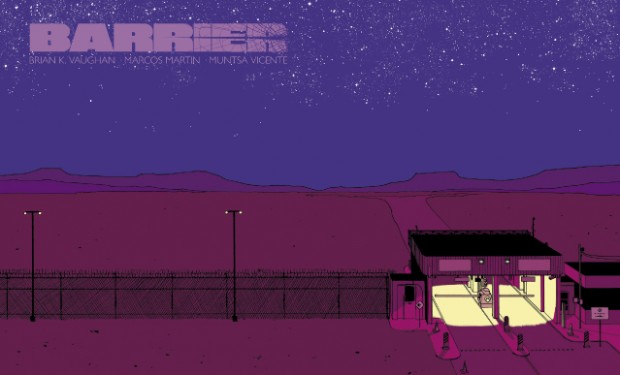Barrier #1 (Panel Syndicate)
 In Barrier #1 the latest offering from Brian K Vaughan and Marcos Martin’s Eisner award winning, pay-what-you-want publishing platform Panel Syndicate sees The Private Eye creative team look at the subject of immigration as only they can in this bilingual digital exclusive new series. But will it’s maverick story-telling create a barrier between the creators and their audience?
In Barrier #1 the latest offering from Brian K Vaughan and Marcos Martin’s Eisner award winning, pay-what-you-want publishing platform Panel Syndicate sees The Private Eye creative team look at the subject of immigration as only they can in this bilingual digital exclusive new series. But will it’s maverick story-telling create a barrier between the creators and their audience?
 Publisher: Panel Syndicate
Publisher: Panel Syndicate
Writer: Brian K Vaughan
Artist: Marcos Martin, Muntsa Vicente
Price: Pay what you want
[yasr_overall_rating size=”large”]
As you would expect from the team behind the Eisner Award winning The Private Eye, Brian K Vaughan and Marcos Martin’s Barrier continues to push the boundaries of sequential story-telling in new and exciting directions – and not just when it comes to the matter of digital self-publishing.
After the technical future noir of The Private Eye, Vaughan and Martin are back in the present day, in Pharr, Texas to be precise – a landscape full of full of dusky sunsets, slithering rattlesnakes and sprawling sandy vistas. Our story starts out as ranch boss Liddy is called on to investigate the discovery of a gruesome skinned horse’s head which has been left by the local drugs cartel as a Godfather style message – or is it something more sinister? As Liddy looks to enlist help from local rednecks to protect her ranch we are drawn into a world of small-town resentments about those crossing the border illegally and the crime and issues that they bring with them.
This north of the border perspective is counter-balanced with a parallel story about Oscar, a south of the border immigrant looking to make his way to the USA via some unscrupulous gang bosses. When the story flips to Oscar’s point of view, as well as shifting narrative focus, the story also changes languages and is told in Martin’s native Spainish. It’s a slightly unsettling shift for those non-bilingual readers and leaves you with the option to either use Google Translate, find a friendly Spainish speaker, or just follow the story visually.
Thanks to Martin’s superb story-telling you can quite easily do the latter, and it is certainly a bold story-telling idea which only someone with the supreme confidence of Vaughan and Martin could pull of, however we aren’t quite sure how successful it is. As a non-Spainish speaker we found it to be a quite distracting device as we lost the flow of the story and it required a different way of reading these pages when not being able to understand the speech bubbles. Although none of the overall story is lost thanks to the visuals, inevitably the subtleties of these scenes will have been lost on non-Spainish speakers (and of course the opposite for non-English speakers!) which is a shame, as Vaughan’s work is packed full of so much depth that it seems wrong to miss out on half the story – unless you are bilingual of course!
As we go back and forth between the tales of Oscar and Liddy our two characters inevitably collide for the stories finale at which point the direction takes a radical about turn, which we won’t spoil here. Suffice to say it manages to completely change the complexion of the story for issue #2 and sets up a truly intriguing premise for the rest of the series! Up until the final page, the story appears to be heading towards a clichéd romance between these two characters from different sides of the fence, and Martin and Vaughan do a superb job taking us along that route with some beautiful split screen pages in the final third that see our two characters lives happening in stark contrast to one another.
However, the conclusion comes out of nowhere like a sudden slap to the face and completely changes your understanding of what you have just finished reading and helps elevate the meandering charm of the first 50+ pages and turn it into something really exciting. It’s a device we have seen Vaughan use expertly in Saga and his other work as he sideswipes the audience and gives you a compelling reason to come back for another issue, and this one really is a stunner and rewards all those who persevere through the language shifts.
Visually, Martin shows his range by creating a completely fresh look and feel for the book compared to The Private Eye. The clean stark lines of the future are replaced with the gritty detail of the southern USA, with lots of intense close-ups on detail like the decomposing horse’s head, or the fly that circles it. It makes his work feel more like a piece of expressionist cinema than a comic book and maximises the landscape format with an increased confidence. Martin’s artwork is brought to life with Muntsa Vicente’s sublime colours, especially the vibrant desert sunsets, are juxtaposed perfectly with the murky world of the traffic smugglers.
 “Although not quite as ground-breaking as The Private Eye, or as downright entertaining as Panel Syndicate’s Universe from Albert Monteys, Barrier is a unique read with a truly jaw-dropping finale. The bilingual experiment may make the reading experience more complex than it needs to be, but don’t let it be a blockade to your enjoyment, as this is another out of this world offering from Vaughan and Martin.”
“Although not quite as ground-breaking as The Private Eye, or as downright entertaining as Panel Syndicate’s Universe from Albert Monteys, Barrier is a unique read with a truly jaw-dropping finale. The bilingual experiment may make the reading experience more complex than it needs to be, but don’t let it be a blockade to your enjoyment, as this is another out of this world offering from Vaughan and Martin.”


December 20, 2025 @ 5:21 pm
Das Happy Hugo Casino überzeugt mit einer beeindruckenden Casinospiele Auswahl.
Die Kombination aus Willkommensbonus, regelmäßigen Aktionen und dem VIP-Programm sorgt für langfristigen Spielspaß.
Happy Hugo Casino bietet attraktive Casino Bonusangebote für Neukunden und Stammgäste.
Sie lädt schnell und bietet Zugang zu über 5000 Casino-Spielen.
Ein kleiner FAQ-Bereich kann bei einfacheren Anliegen aushelfen, sollte aber noch ausgebaut
werden. Datenübertragungen, Zahlungen und sonstige Kommunikation mit
dem Casino wird mittels 128-Bit-TLS-Verschlüsselung gesichert.
Und es kommt noch ein wöchentlicher Wettbewerb hinzu, bei dem Sie einen Anteil eines Jackpots gewinnen können. Die groben Kategorien teilen das Sortiment nur in Slots, Tischspiele, Live Casino, beliebte
Spiele und Neuheiten sowie Ihre Favoriten ein. Die Curacao-Lizenz und SSL-Verschlüsselung sorgen für einen sicheren Spielrahmen.
Diese Lizenzierung unterstreicht die Bemühungen des Casinos, einen sicheren und regulierten Spielraum zu
schaffen. Das Happy Hugo Casino, gegründet 2016, bietet
Spielern ein umfangreiches Online Casino Erfahrungen. Für Kryptowährung-Enthusiasten bietet Happy Hugo auch Bitcoin als Zahlungsoption an. Leider
ist Happy Hugo kein vollständig mobil angepasstes Casino und bietet keine sehr zufriedenstellende
Erfahrung für mobile Benutzer.
References:
https://online-spielhallen.de/umfassende-bewertung-des-venlo-casinos-ein-erfahrener-spielerblick/
December 27, 2025 @ 1:13 am
This aspect of safety is crucial when we review casinos, and we focus on several key benchmarks to ensure a safe experience.
Every Australia online casino should make safety
and security a top priority for all users. We like casino bonuses, but not enough to claim them blindly without checking what’s
important. You’ve had your fill of fun and games in the
pokies lobby or at the roulette table, and you are proud
to leave with some profit. While casinos with a wide variety of pokies have an advantage, it’s not the only important thing.
Crash games have exploded in popularity at Australian crypto casinos.
It’s the go-to card game at many Australian casinos online.
A few sites even let you play crypto slots or crash games for something different.
You’ll find thousands of pokies, dozens of blackjack and
roulette tables, and live-streamed dealer games. Once you’ve picked up a bonus
or two, the real fun starts with the huge range of games on offer.
December 27, 2025 @ 12:27 pm
Educating users about the benefits and risks of automated
financial solutions is crucial for widespread adoption.
Compliance with existing and future regulations poses a challenge for automated financial solutions.
Additionally, over-reliance on historical data may
not account for future market anomalies. All transactions and
portfolio adjustments are recorded on the blockchain, providing an auditable trail.
Automated systems can continuously monitor portfolios and implement risk
management strategies to protect against market volatility.
Advanced algorithms can analyze vast amounts of data and execute trades based on real-time market conditions.
You can also find outlooks on green and socially responsible investment strategies, including Environmental, Social and Governance (ESG) products.
Some providers offer online books, PDFs, newsletters, podcasts, and videos that detail everything from the latest market trends
to investment planning templates. Therefore, they must
sign up with the US SEC before launching services online.
With that said, expense ratios can be a helpful way to consider the investment propositions on offer.
As a result, it’s difficult to accurately report on their
performance.
“It’s time for the people who run this casino to recognize the workers who make their profits possible. Across the country, from the bright lights of Las Vegas to relaxing Gulf Coast resort destinations, you’ll find exclusive savings on hotel stays, dining, entertainment, and more. And with these exclusive Las Vegas hotel deals, you can experience this elevated escape while still being smart with your budget. And with these exclusive Las Vegas hotel deals, you can experience it all without overspending. Nestled in the center of the Strip, this historic hotel is more than just a place to stay—it’s a place to discover.
References:
https://blackcoin.co/top-online-casinos-with-instant-withdrawal-payouts-2025/
December 29, 2025 @ 5:12 am
online casino that accepts paypal
References:
excelrenforcement.com
December 29, 2025 @ 5:31 am
online blackjack paypal
References:
https://skilling-india.com